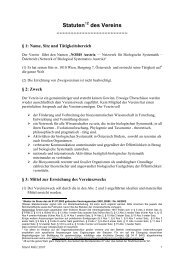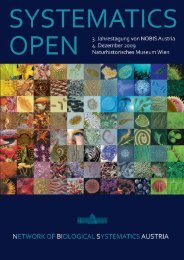4. Jahrestagung von NOBIS Austria 2. - 3. Dezember 2010
4. Jahrestagung von NOBIS Austria 2. - 3. Dezember 2010
4. Jahrestagung von NOBIS Austria 2. - 3. Dezember 2010
Create successful ePaper yourself
Turn your PDF publications into a flip-book with our unique Google optimized e-Paper software.
Phylogeography and synchronous diversification of the Corvus<br />
corvids of the world<br />
Gamauf, A. 1 , Däubl, B. 1 , Kryukov, A. 2 , Pinsker, W. 1 & Haring, E. 1<br />
1 Museum of Natural History Vienna, Dept. Vertebrate Zoology, Burgring 7, A-1010 Vienna, <strong>Austria</strong>;<br />
elisabeth.haring@nhm-wien.ac.at<br />
2 Institute of Biology and Soil Science, Russian Academy of Sciences, Vladivostok 690022, Russia.<br />
The genus Corvus with its approximately 40 species is world wide distributed, except S America.<br />
Highest diversity is found in Australasia and SE Asian islands. Ten species (25%) are coloured black<br />
and white/grey, the rest are completely black.<br />
We investigated the phylogeny of the genus Corvus employing DNA sequences of the mitochondrial<br />
control region. The study was based mainly on museum material allowing the analysis of more than 30<br />
species. Inclusion of sequences of other corvid genera as available in GenBank confirmed the<br />
monophyly of the genus Corvus. Within the Corvus clade several distinct subclades can be<br />
distinguished. Some contain only single species or species pairs (e.g., C. monedula + C. dauricus; C.<br />
frugilegus; C. palmarum) while other clades are composed of many species (e.g., the Holarctic and<br />
African clade or the SE and E Asian clade). In general, the composition of the clades reflects<br />
geographic contiguousness. The basal relationships among clades remain unresolved with this marker<br />
sequence.<br />
It is remarkable that each clade contains black as well as white/grey coloured representatives. None of<br />
the latter are found in N America, whereas almost all African species south of the Sahara show black-<br />
white pattern. The most parsimonious explanation for the distribution of plumage colour in the<br />
phylogenetic tree is that the pale markings evolved at least five times independently. The assumption<br />
that the white/grey colour pattern - which is found also in other genera of the family Corvidae, e.g.,<br />
Pica - is the plesiomorphic state, is less likely.<br />
_____________________________________________________________________________<br />
14 Ber. Inst. Erdwiss. K.-F.-Univ. Graz, Band 15, <strong>2010</strong>; ISSN 1608-8166






